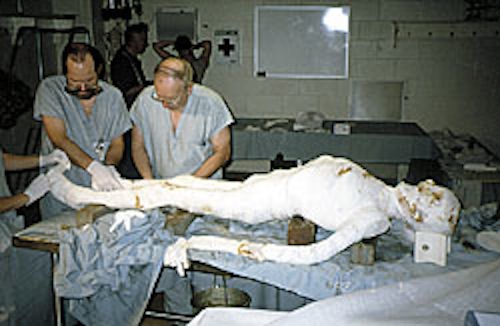How to Make a Mummy: According to Bob Brier and Robert Wade March 27, 2014
Author: Beach Combing | in : Ancient , trackbackChecklist. You don’t believe in the resurrection of the dead? You are not squeamish about your body being messed around with after you have passed? You have no dangerous blood-bourne diseases? And you would like a form of immortality? Then why not volunteer to become an Egyptian mummy? This anyway is what happened 24 May 1994 when Egyptologist, Bob Brier got together with surgeon Rob Wade (University of Maryland) and they decided that they wanted to better understand how mummies were, well, mummified. A body was taken, though the actual origins of this corpse were never revealed to Brier. Then Brier and Wade set out, using various ancient sources, from Herodotus to magical papyri, to turn flesh to mummy. Anyone who knows Brier’s work will not be surprised to learn that he and Wade took the project extremely seriously. Ancient Egyptian natron came from the Wadi Natrun and so Brier went there to personally collect the substance used to dry ancient Egyptian corpses: 400 pounds! They needed to mimic the Egyptians bronze tools, so they found a silversmith who could beat bronze to order, moulds don’t give a sharp enough edge. They needed some frankincense and myrrh: off Brier went to Cairo market. They arguably let themselves down with the palm wine though that they had to ship in from Nigeria: talk about slackness… (In fairness it seemed that palm wine had vanished from the Mediterranean with the advent of Islam). However, they decided that it was a good omen that there was a pyramid on the Nigerian bottle.
They followed the instructions for mummification as closely as they could using ancient authorities and particularly Diodorus Siculus and, of course, Herodotus. They removed all the adbominal organs through a two and a half inch slit, a slit that was cut with obsidian: though actually they found the slit was slightly too small, perhaps the ancient measurements were off, perhaps with more practice? They even managed to get the liver out after cutting to three inches: ‘One lobe following the next out, much like delivering a newborn baby at term.’ Most challenging though was the brain. The general belief was that the brain was removed through the nose by a long coat-hanger like instrument bit by bit. They found after experimenting on several heads – and skip this extremely unpleasant detail if you want – that they best way to get the brain out was to use the ‘coat hanger’ as a whisk and reduce the brain to liquid. The brain was then allowed to drip out through the nose. For those of you who are wondering the whisking took twenty minutes and the draining an hour and a half. They then packed the body with natron and left it for, on the basis of ancient instructions, thirty five days and found that the body was essentially mummified at the end of this time: but that there was still enough liquid to allow the body to be set in position, e.g. the arms could be crossed. Twenty years have since passed and by all accounts the mummy is going fine. In fact, it has become a bench mark for comparisons with ancient mummies and is regularly unwrapped, x-rayed and generally pampered. Having said that I think I’ll opt for cremation rather than the bronze coat hanger whisk up my left nostril. Get thee behind me, Brier!
I have previously reviewed an attempt to replicate ancient Mayan sacrifice using a corpse and I can’t help wondering whether other historians have played around with dead bodies: drbeachcombing AT yahoo DOT com There is so much potential if you have a strong stomach.We’ve only found one other Egyptian example though. BB mentions that the German mummy pioneer Sudhoff writes, in an apparent aside, that he had removed brains in the Egyptian manner in the very early twentieth century: boasting, fantasy, fact? Then W. Leek tried in the late 1960s to do it with a sheep and a colleague (Patterson) claimed, in an appendix, to have done the same with a human brain: in fact, Patterson pioneered the whisk method but there is a frustrating lack of detail.
In any case, it is with great pride that we induct Bob and Rob to the Rogue Researchers hall of fame for unusual/eccentric scholarly activity. Way to go, boys!
If you want to know more about Brier and mummies this gives the details in an interesting lesson: he’s an outstanding lecturer with a lovely Bronx accent.
Brier, Bob Egyptian Mummies: Unraveling the Secrets of an Ancient Art (Harper 1996)
Brier, Bob and Ronald S. Wade, ‘Surgical Procedures During Ancient Mummification’, Chungara: Revista de Antropología Chilena 33 (2001), 117-123 [behind jstor paywall]
Leek, F.F. ‘The Problem of Brain Removal During Embalming by the Ancient Egyptians’, Journal of Egyptian Archaeology 55 (1969) 112-116.



